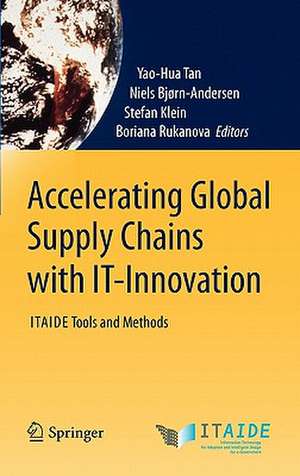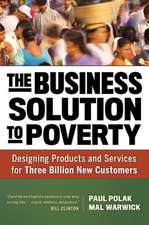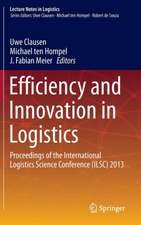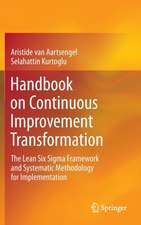Accelerating Global Supply Chains with IT-Innovation: ITAIDE Tools and Methods
Editat de Yao-Hua Tan, Niels Bjørn-Andersen, Stefan Klein, Boriana Rukanovaen Limba Engleză Hardback – 27 oct 2010
To address these conflicting demands, the ITAIDE project has developed a large set of innovative IT-related tools and methods that enable companies to be better in control of their business operations. These tools and methods have been integrated in the ITAIDE Information Infrastructure (I3) framework.
By using the I3 framework, companies are better positioned to apply for the Trusted Trader status, and enjoy trade facilitation benefits such as simplified customs procedures and fewer inspections of their goods. Hence, the I3 framework can contribute to making global supply chains faster, cheaper, and more secure.
The I3 framework has been tested and validated in five real-life Living Labs, spanning four different sectors of industry, and conducted in five different EU countries. National Tax & Customs organizations from various European countries have actively participated in the Living Labs.
The United Nations CEFACT group, experts from the World Customs Organization and representatives of key industry associations have also provided valuable feedback and ideas for the Living Labs and the project in general.
www.itaide.org
| Toate formatele și edițiile | Preț | Express |
|---|---|---|
| Paperback (1) | 792.33 lei 38-44 zile | |
| Springer Berlin, Heidelberg – 13 oct 2014 | 792.33 lei 38-44 zile | |
| Hardback (1) | 955.08 lei 6-8 săpt. | |
| Springer Berlin, Heidelberg – 27 oct 2010 | 955.08 lei 6-8 săpt. |
Preț: 955.08 lei
Preț vechi: 1164.73 lei
-18% Nou
Puncte Express: 1433
Preț estimativ în valută:
182.81€ • 198.64$ • 153.66£
182.81€ • 198.64$ • 153.66£
Carte tipărită la comandă
Livrare economică 21 aprilie-05 mai
Preluare comenzi: 021 569.72.76
Specificații
ISBN-13: 9783642156687
ISBN-10: 3642156681
Pagini: 392
Ilustrații: XI, 379 p.
Dimensiuni: 155 x 235 x 30 mm
Greutate: 0.72 kg
Ediția:2011
Editura: Springer Berlin, Heidelberg
Colecția Springer
Locul publicării:Berlin, Heidelberg, Germany
ISBN-10: 3642156681
Pagini: 392
Ilustrații: XI, 379 p.
Dimensiuni: 155 x 235 x 30 mm
Greutate: 0.72 kg
Ediția:2011
Editura: Springer Berlin, Heidelberg
Colecția Springer
Locul publicării:Berlin, Heidelberg, Germany
Public țintă
ResearchCuprins
Part 1: Introduction
Chapter 1: Introduction . . . . . . . . . . . . . . . . . . . . . . . . . . . . . . . . . . . . . . . . . . 3
Boriana Rukanova, Niels Bjørn-Andersen, Fred van Ipenburg, Stefan Klein,
Godfried Smit, Yao-Hua Tan
Part 2: Living Labs
Chapter 2: Introduction to the Living Lab Approach . . . . . . . . . . . . . . . . . 31
Allen Higgins, Stefan Klein
Chapter 3: Beer Living Lab – Intelligent Data Sharing . . . . . . . . . . . . . . . . 37
Boriana Rukanova, Ziv Baida, Jianwei Liu, Eveline van Stijn, Yao-Hua Tan,
Wout Hofman, Rolf T. Wigand, Fred van Ipenburg
Chapter 4: Paper Living Lab – Integration of SMEs . . . . . . . . . . . . . . . . . . 55
Jussi Autere, Kari Korpela, Katrine Augustinussen
Chapter 5: Food Living Lab – Complexity of Export Trade . . . . . . . . . . . . 73
Stefan Henningsson, Niels Bjørn-Andersen, Alexander Schmidt,
Barbara Flügge, Helle Zinner Henriksen
Chapter 6: Drug Living Lab – Cold Chain Monitoring . . . . . . . . . . . . . . . . 91
Allen Higgins
Chapter 7: Drug Living Lab – Supply Chain Security and Control . . . . . . 109
Stefan Klein, Allen Higgins, Alexander Kipp, Anita Mangan
Chapter 8: The Concept of Living Labs as Social Infrastructures
for Innovation . . . . . . . . . . . . . . . . . . . . . . . . . . . . . . . . . . . . . . . . . . . . . . . . . . 123
Allen Higgins, Stefan Klein
Part 3: ITAIDE Information Infrastructure (I3) Framework
Chapter 9: ITAIDE Information Infrastructure (I3) Framework . . . . . . . 137
Stefan Henningsson, Richard Budel, Uri Gal, Yao-Hua Tan
Chapter 10: Information Technology (IT) . . . . . . . . . . . . . . . . . . . . . . . . . . . 157
Ziv Baida, Frank Koldijk, Yao-Hua Tan, Allen Higgins
Chapter 11: Standardised Data Models . . . . . . . . . . . . . . . . . . . . . . . . . . . . . 175
Barbara Flügge, Alexander Schmidt, Marta Raus, Tobias Vogel
Chapter 12: Interoperability Tools . . . . . . . . . . . . . . . . . . . . . . . . . . . . . . . . . 201
Slawomir Ulankiewicz, Stefan Henningsson, Niels Bjørn-Andersen,
Barbara Flügge
Chapter 13: Procedure Redesign Methods . . . . . . . . . . . . . . . . . . . . . . . . . . 223
Jianwei Liu, Wout Hofman and Yao-Hua Tan
Chapter 14: Network Collaboration Models . . . . . . . . . . . . . . . . . . . . . . . . . 255
Stefan Klein, Allen Higgins, Boriana Rukanova
Part 4: Lessons for Practice
Chapter 15: Value Assessment of Business-to-Government
IT Innovations: The Case of e-Customs . . . . . . . . . . . . . . . . . . . . . . . . . . . . . 273
Alexander Kipp, Marta Raus, Janwei Liu, Stefan Klein
Chapter 16: Implementation Framework for e-Solutions
for Trade Facilitation . . . . . . . . . . . . . . . . . . . . . . . . . . . . . . . . . . . . . . . . . . . . 285
Eveline van Stijn, Thayanan Phuaphanthong, Somnuk Keretho,
Markus Pikart, Wout Hofman, Yao-Hua Tan
Part 5: Conclusions
Chapter 17: Conclusions . . . . . . . . . . . . . . . . . . . . . . . . . . . . . . . . . . . . . . . . . 321
Yao-Hua Tan, Niels Bjorn-Andersen, Stefan Klein, Boriana Rukanova,
Fred van Ipenburg, Godfried Smit
Glossary . . . . . . . . . . . . . . . . . . . . . . . . . . . . . . . . . . . . . . . . . . . . . . . . . . . . . . . 333
Annex 1: Overview of Systems Envisaged in the MASP . . . . . . . . . . . . . . . 343
Annex 2: AS-IS Process Model for Beer Export to the US . . . . . . . . . . . . . 351
Annex 3: The Legal Environment of the MASP . . . . . . . . . . . . . . . . . . . . . 352
Annex 4: Stepwise Approach to Derive Deployable Artifacts . . . . . . . . . . 353
Annex 5: Simplified Interaction Model for the Export
of Dairy Products from Denmark to Russia . . . . . . . . . . . . . . . . 354
Annex 6: Excerpt of an XML Schema for Goods Items that are Applied
in Transit Declarations . . . . . . . . . . . . . . . . . . . . . . . . . . . . . . . . . 355
List of Abbreviations . . . . . . . . . . . . . . . . . . . . . . . . . . . . . . . . . . . . . . . . . . . . 357
List of References . . . . . . . . . . . . . . . . . . . . . . . . . . . . . . . . . . . . . . . . . . . . . . . 363
Chapter 1: Introduction . . . . . . . . . . . . . . . . . . . . . . . . . . . . . . . . . . . . . . . . . . 3
Boriana Rukanova, Niels Bjørn-Andersen, Fred van Ipenburg, Stefan Klein,
Godfried Smit, Yao-Hua Tan
Part 2: Living Labs
Chapter 2: Introduction to the Living Lab Approach . . . . . . . . . . . . . . . . . 31
Allen Higgins, Stefan Klein
Chapter 3: Beer Living Lab – Intelligent Data Sharing . . . . . . . . . . . . . . . . 37
Boriana Rukanova, Ziv Baida, Jianwei Liu, Eveline van Stijn, Yao-Hua Tan,
Wout Hofman, Rolf T. Wigand, Fred van Ipenburg
Chapter 4: Paper Living Lab – Integration of SMEs . . . . . . . . . . . . . . . . . . 55
Jussi Autere, Kari Korpela, Katrine Augustinussen
Chapter 5: Food Living Lab – Complexity of Export Trade . . . . . . . . . . . . 73
Stefan Henningsson, Niels Bjørn-Andersen, Alexander Schmidt,
Barbara Flügge, Helle Zinner Henriksen
Chapter 6: Drug Living Lab – Cold Chain Monitoring . . . . . . . . . . . . . . . . 91
Allen Higgins
Chapter 7: Drug Living Lab – Supply Chain Security and Control . . . . . . 109
Stefan Klein, Allen Higgins, Alexander Kipp, Anita Mangan
Chapter 8: The Concept of Living Labs as Social Infrastructures
for Innovation . . . . . . . . . . . . . . . . . . . . . . . . . . . . . . . . . . . . . . . . . . . . . . . . . . 123
Allen Higgins, Stefan Klein
Part 3: ITAIDE Information Infrastructure (I3) Framework
Chapter 9: ITAIDE Information Infrastructure (I3) Framework . . . . . . . 137
Stefan Henningsson, Richard Budel, Uri Gal, Yao-Hua Tan
Chapter 10: Information Technology (IT) . . . . . . . . . . . . . . . . . . . . . . . . . . . 157
Ziv Baida, Frank Koldijk, Yao-Hua Tan, Allen Higgins
Chapter 11: Standardised Data Models . . . . . . . . . . . . . . . . . . . . . . . . . . . . . 175
Barbara Flügge, Alexander Schmidt, Marta Raus, Tobias Vogel
Chapter 12: Interoperability Tools . . . . . . . . . . . . . . . . . . . . . . . . . . . . . . . . . 201
Slawomir Ulankiewicz, Stefan Henningsson, Niels Bjørn-Andersen,
Barbara Flügge
Chapter 13: Procedure Redesign Methods . . . . . . . . . . . . . . . . . . . . . . . . . . 223
Jianwei Liu, Wout Hofman and Yao-Hua Tan
Chapter 14: Network Collaboration Models . . . . . . . . . . . . . . . . . . . . . . . . . 255
Stefan Klein, Allen Higgins, Boriana Rukanova
Part 4: Lessons for Practice
Chapter 15: Value Assessment of Business-to-Government
IT Innovations: The Case of e-Customs . . . . . . . . . . . . . . . . . . . . . . . . . . . . . 273
Alexander Kipp, Marta Raus, Janwei Liu, Stefan Klein
Chapter 16: Implementation Framework for e-Solutions
for Trade Facilitation . . . . . . . . . . . . . . . . . . . . . . . . . . . . . . . . . . . . . . . . . . . . 285
Eveline van Stijn, Thayanan Phuaphanthong, Somnuk Keretho,
Markus Pikart, Wout Hofman, Yao-Hua Tan
Part 5: Conclusions
Chapter 17: Conclusions . . . . . . . . . . . . . . . . . . . . . . . . . . . . . . . . . . . . . . . . . 321
Yao-Hua Tan, Niels Bjorn-Andersen, Stefan Klein, Boriana Rukanova,
Fred van Ipenburg, Godfried Smit
Glossary . . . . . . . . . . . . . . . . . . . . . . . . . . . . . . . . . . . . . . . . . . . . . . . . . . . . . . . 333
Annex 1: Overview of Systems Envisaged in the MASP . . . . . . . . . . . . . . . 343
Annex 2: AS-IS Process Model for Beer Export to the US . . . . . . . . . . . . . 351
Annex 3: The Legal Environment of the MASP . . . . . . . . . . . . . . . . . . . . . 352
Annex 4: Stepwise Approach to Derive Deployable Artifacts . . . . . . . . . . 353
Annex 5: Simplified Interaction Model for the Export
of Dairy Products from Denmark to Russia . . . . . . . . . . . . . . . . 354
Annex 6: Excerpt of an XML Schema for Goods Items that are Applied
in Transit Declarations . . . . . . . . . . . . . . . . . . . . . . . . . . . . . . . . . 355
List of Abbreviations . . . . . . . . . . . . . . . . . . . . . . . . . . . . . . . . . . . . . . . . . . . . 357
List of References . . . . . . . . . . . . . . . . . . . . . . . . . . . . . . . . . . . . . . . . . . . . . . . 363
Textul de pe ultima copertă
One of the major challenges for European governments is to solve the dilemma of increasing the security and reducing fraud in international trade, while at the same time reducing the administrative burden for commercial as well as public administration organisations.
To address these conflicting demands, the ITAIDE project has developed a large set of innovative IT-related tools and methods that enable companies to be better in control of their business operations. These tools and methods have been integrated in the ITAIDE Information Infrastructure (I3) framework.
By using the I3 framework, companies are better positioned to apply for the Trusted Trader status, and enjoy trade facilitation benefits such as simplified customs procedures and fewer inspections of their goods. Hence, the I3 framework can contribute to making global supply chains faster, cheaper, and more secure.
The I3 framework has been tested and validated in five real-life Living Labs, spanning four different sectors of industry, and conducted in five different EU countries. National Tax & Customs organizations from various European countries have actively participated in the Living Labs.
The United Nations CEFACT group, experts from the World Customs Organization and representatives of key industry associations have also provided valuable feedback and ideas for the Living Labs and the project in general.
www.itaide.org
To address these conflicting demands, the ITAIDE project has developed a large set of innovative IT-related tools and methods that enable companies to be better in control of their business operations. These tools and methods have been integrated in the ITAIDE Information Infrastructure (I3) framework.
By using the I3 framework, companies are better positioned to apply for the Trusted Trader status, and enjoy trade facilitation benefits such as simplified customs procedures and fewer inspections of their goods. Hence, the I3 framework can contribute to making global supply chains faster, cheaper, and more secure.
The I3 framework has been tested and validated in five real-life Living Labs, spanning four different sectors of industry, and conducted in five different EU countries. National Tax & Customs organizations from various European countries have actively participated in the Living Labs.
The United Nations CEFACT group, experts from the World Customs Organization and representatives of key industry associations have also provided valuable feedback and ideas for the Living Labs and the project in general.
www.itaide.org
Caracteristici
How to achieve accelerated trade by making use of IT-related innovations
Includes supplementary material: sn.pub/extras
Includes supplementary material: sn.pub/extras











